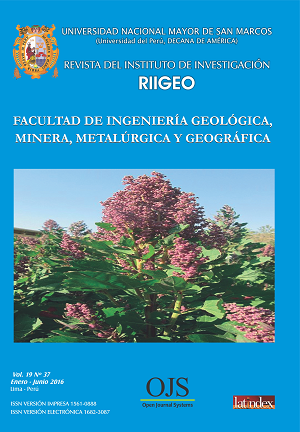Mineralogy and genesis of manganese pisolites from the Do Azul mine (Carajás, Brazil)
DOI:
https://doi.org/10.15381/iigeo.v19i37.12964Keywords:
Manganese pisoliths, mineralogy, supergenic processes, lateritesAbstract
In the Do Azul mine, the manganese pisoliths are scattered in irregular layers of lateritic rocks, which form small hills, covering the slopes and surfaces with colluvial materials from the Igarapé Do Azul plateau. They are packages that reach up to 8 meters thick and are of great importance for understanding the processes of formation of manganese superegenous deposits. The pisoliths have spherical, sub-spherical and also angular shapes, the size of their diameters varies from 0.5 to 8 mm and are normally made up of a nucleus, surrounded by concentric layers. For the most part, the cores and layers are well differentiated. The nuclei can occupy from 10 to 80% of the total volume of each pisolite and are mainly made up of Mn oxides and hydroxides such as: cryptomelan, pyrolusite, lithophorite, hollandite, todorokite and birnessite, also occurring gibbsite, kaolinite and anatase in variable amounts , and in some nuclei quartz is present. Fe and Al oxides and hydroxides predominate in the concentric layers, such as kaolinite, goethite, gibbsite and anatase, with cryptomelan and lithophorite lenses, also micro cavities filled with pyrolusite. These data demonstrate that the nuclei of the pisoliths represent the physical disaggregation of the underlying and adjacent materials, mainly manganese mineralization, and their layers, the aggregation of the superimposed lateritic profile by means of downhill transport. Pisoliths are excellent indicators for prospecting manganese mineralizations.
Downloads
Published
Issue
Section
License
Copyright (c) 2016 Maritza M. Cantorín Vílchez

This work is licensed under a Creative Commons Attribution-NonCommercial-ShareAlike 4.0 International License.
AUTHORS RETAIN THEIR RIGHTS:
a. Authors retain their trade mark rights and patent, and also on any process or procedure described in the article.
b. Authors retain their right to share, copy, distribute, perform and publicly communicate their article (eg, to place their article in an institutional repository or publish it in a book), with an acknowledgment of its initial publication in the Rev. Inst. investig. Fac. minas metal cienc. geogr.
c. Authors retain theirs right to make a subsequent publication of their work, to use the article or any part thereof (eg a compilation of his papers, lecture notes, thesis, or a book), always indicating the source of publication (the originator of the work, journal, volume, number and date).






